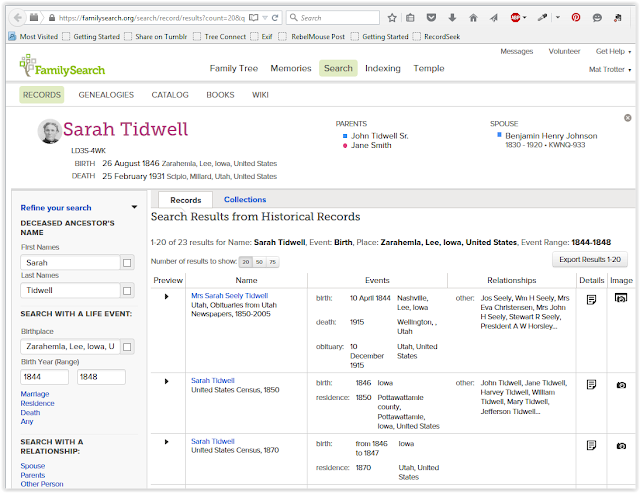Where do you find records?
We have gathered information and decided to begin looking for a specific ancestor. As a beginner we want to start with the information that we know.
I always begin my search at FamilySearch, the largest collection of genealogical and historical records in the world. The best part is that it is free to use either with or without a free account.
The search feature allows you to search by Name or Location. To search by name enter in information on the left side of the page. Sometimes adding or removing information from the search will give you more or less results. It is a good practice when searching to start with a small amput of information and then narrow the search.
For this search I want to learn more about my second great-grandmother Christina McKay and her family. I know that the image says third great-grandmother but my legacy database hase my oldest son as record number one so I can have all of my data in one database.
I know that She died in 1925 in Los Angeles, I will begin with a search there. I decided to use the name search and I entered her name and death place and date.
The top five search results were for my Christina and two of these were records for her death. It is ok if the birth date is not quite right because we are focused on the death information. If this were birth records we would have to look more closely.
The Find a Grave record and the California Death Index record confirm this is my Christena. The headstone from Find-A-Grave gives me her Husband's Birth and death year. I also know burial custom is that one or both of them must have lived in or near Pamona, Calfornia at some point in their lives because that is where the grave is located.
The 1900, 1910, and 1920 Census records confirm Christena living in California first with her husband Everett but in 1920 with her daughter. This backs up the dates from the headstone that Everett most likely died before the 1920 census.
The biggest clues from the census records is that Christena's birthplace is listed as Canada and both of her parents were born in Scotland. Other information contained here is that her birthdate is in Dec 1954 and she immigrated to the United States in 1884. Both of these dates are secondary and need to be supported with primary sources but they provide great clues as to when to look for more information. It also says they have been married for 28 years so they were married around 1872.
A quick search for a Christena McKay married in Canada between 1871 and 1873 find an Ontario, Canada Marriage record between Christina McKay and Everett Merriam. I cannot show the image of the record because of Intellectual agreements but the information from the record gives us more clues for where to look for more information. Everett's parents names are Justus and Caroline Merriam. His brothers marriage record is on the same page and his name is Rustin Merriam. They lived in Chatsworth, Canada when Everett was married at the age of 23. Christina's parents are Angus and Hannah McKay. They lived in Sydenham, Canada when Christina was married at the age of 18. They were married on September 24, 1872 in Owen Sound, Grey County, Ontario, Canada by Rev. William Tindall. Everett's brother was married the same day.

























